In-Situ Chemical Thinning and Surface Doping of Layered Bi2Se3
Abstract
1. Introduction
2. Materials and Methods
2.1. Materials and Chemicals
2.2. Chemical Thinning Methods
2.3. Characterization
3. Results and Discussion
3.1. In-Situ Chemical Thinning and Surface Doping of Bulk-Layered Bi2Se3
3.2. Controllable Exfoliation of Large-Size Layered Bi2Se3
3.3. Raman Analysis of the Exfoliated Samples
3.4. Surface Morphology and Element Content Analysis of the Exfoliated Samples
3.5. XPS Characterization of the Exfoliated Samples
4. Conclusions
Author Contributions
Funding
Institutional Review Board Statement
Informed Consent Statement
Data Availability Statement
Conflicts of Interest
References
- Novoselov, K.S.; Geim, A.K.; Morozov, S.V.; Jiang, D.; Zhang, Y.; Dubonos, S.V.; Grigorieva, I.V.; Firsov, A.A. Electric Field Effect in Atomically Thin Carbon Films. Science 2004, 306, 666–669. [Google Scholar] [CrossRef] [PubMed]
- Ashworth, C. 2D Materials: The Thick and the Thin. Nat. Rev. Mater. 2018, 3, 18019. [Google Scholar] [CrossRef]
- Schaibley, J.R.; Yu, H.; Clark, G.; Rivera, P.; Ross, J.S.; Seyler, K.L.; Yao, W.; Xu, X. Valleytronics in 2D Materials. Nat. Rev. Mater. 2016, 1, 16055–16069. [Google Scholar] [CrossRef]
- Long, M.; Wang, P.; Fang, H.; Hu, W. Progress, Challenges, and Opportunities for 2D Material Based Photodetectors. Adv. Funct. Mater. 2019, 29, 1803807–1803834. [Google Scholar] [CrossRef]
- Cao, Y.; Fatemi, V.; Fang, S.; Watanabe, K.; Taniguchi, T.; Kaxiras, E.; Jarillo-Herrero, P. Unconventional Superconductivity in Magic-Angle Graphene Superlattices. Nature 2018, 556, 43–50. [Google Scholar] [CrossRef] [PubMed]
- Chaves, A.; Azadani, J.G.; Alsalman, H.; da Costa, D.R.; Frisenda, R.; Chaves, A.J.; Song, S.H.; Kim, Y.D.; He, D.; Zhou, J.; et al. Bandgap Engineering of Two-Dimensional Semiconductor Materials. npj 2D Mater. Appl. 2020, 4, 29–49. [Google Scholar] [CrossRef]
- Mao, N.; Tang, J.; Xie, L.; Wu, J.; Han, B.; Lin, J.; Deng, S.; Ji, W.; Xu, H.; Liu, K.; et al. Optical Anisotropy of Black Phosphorus in the Visible Regime. J. Am. Chem. Soc. 2016, 138, 300–305. [Google Scholar] [CrossRef] [PubMed]
- Brumfiel, G. Topological Insulators: Star Material. Nature 2010, 466, 310–311. [Google Scholar] [CrossRef] [PubMed]
- Zhang, H.; Liu, C.X.; Qi, X.L.; Dai, X.; Fang, Z.; Zhang, S.C. Topological Insulators in Bi2Se3, Bi2Te3 and Sb2Te3 with a Single Dirac Cone on the Surface. Nat. Phys. 2009, 5, 438–442. [Google Scholar] [CrossRef]
- Wang, G.; Zhu, X.; Wen, J.; Chen, X.; He, K.; Wang, L.; Ma, X.; Liu, Y.; Dai, X.; Fang, Z.; et al. Atomically Smooth Ultrathin Films of Topological Insulator Sb2Te3. Nano Res. 2010, 3, 874–880. [Google Scholar] [CrossRef]
- Liu, C.-W.; Wang, Z.; Qiu, R.L.J.; Gao, X.P.A. Development of Topological Insulator and Topological Crystalline Insulator Nanostructures. Nanotechnology 2020, 31, 192001–192038. [Google Scholar] [CrossRef] [PubMed]
- Xu, S.; Han, Y.; Chen, X.; Wu, Z.; Wang, L.; Han, T.; Ye, W.; Lu, H.; Long, G.; Wu, Y.; et al. Van Der Waals Epitaxial Growth of Atomically Thin Bi2Se3 and Thickness-Dependent Topological Phase Transition. Nano Lett. 2015, 15, 2645–2651. [Google Scholar] [CrossRef] [PubMed]
- Lin, L.; Peng, H.; Liu, Z. Synthesis Challenges for Graphene Industry. Nat. Mater. 2019, 18, 520–524. [Google Scholar] [CrossRef] [PubMed]
- Ding, Z.; Bux, S.K.; King, D.J.; Chang, F.L.; Chen, T.H.; Huang, S.C.; Kaner, R.B. Lithium Intercalation and Exfoliation of Layered Bismuth Selenide and Bismuth Telluride. J. Mater. Chem. 2009, 19, 2588–2592. [Google Scholar] [CrossRef]
- Hong, S.S.; Kundhikanjana, W.; Cha, J.J.; Lai, K.; Kong, D.; Meister, S.; Kelly, M.A.; Shen, Z.-X.; Cui, Y. Ultrathin Topological Insulator Bi2Se3 Nanoribbons Exfoliated by Atomic Force Microscopy. Nano Lett. 2010, 10, 3118–3122. [Google Scholar] [CrossRef]
- Zang, C.; Qi, X.; Ren, L.; Hao, G.; Liu, Y.; Li, J.; Zhong, J. Photoresponse Properties of Ultrathin Bi2Se3 Nanosheets Synthesized by Hydrothermal Intercalation and Exfoliation Route. Appl. Surf. Sci. 2014, 316, 341–347. [Google Scholar] [CrossRef]
- Jiang, Y.; Zhang, X.; Wang, Y.; Wang, N.; West, D.; Zhang, S.; Zhang, Z. Vertical/Planar Growth and Surface Orientation of Bi2Te3 and Bi2Se3 Topological Insulator Nanoplates. Nano Lett. 2015, 15, 3147–3152. [Google Scholar] [CrossRef]
- Kong, D.; Dang, W.; Cha, J.J.; Li, H.; Meister, S.; Peng, H.; Liu, Z.; Cui, Y. Few-Layer Nanoplates of Bi2Se3 and Bi2Te3 with Highly Tunable Chemical Potential. Nano Lett. 2010, 10, 2245–2250. [Google Scholar] [CrossRef]
- Savariraj, A.D.; Vinoth, V.; Mangalaraja, R.V.; Arun, T.; Contreras, D.; Akbari-Fakhrabadi, A.; Valdés, H.; Banat, F. Microwave-Assisted Synthesis of Localized Surface Plasmon Resonance Enhanced Bismuth Selenide (Bi2Se3) Layers for Non-Enzymatic Glucose Sensing. J. Electroanal. Chem. 2020, 856, 113629–113661. [Google Scholar] [CrossRef]
- Antonova, I.V.; Nebogatikova, N.A.; Kokh, K.A.; Kustov, D.A.; Soots, R.A.; Golyashov, V.A.; Tereshchenko, O.E. Electrochemically Exfoliated Thin Bi2Se3 Films and van Der Waals Heterostructures Bi2Se3/Graphene. Nanotechnology 2019, 31, 125602–125607. [Google Scholar] [CrossRef]
- Ambrosi, A.; Sofer, Z.; Luxa, J.; Pumera, M. Exfoliation of Layered Topological Insulators Bi2Se3 and Bi2Te3 via Electrochemistry. ACS Nano 2016, 10, 11442–11448. [Google Scholar] [CrossRef] [PubMed]
- Ludwig, T.; Guo, L.; McCrary, P.; Zhang, Z.; Gordon, H.; Quan, H.; Stanton, M.; Frazier, R.M.; Rogers, R.D.; Wang, H.T.; et al. Mechanism of Bismuth Telluride Exfoliation in an Ionic Liquid Solvent. Langmuir 2015, 31, 3644–3652. [Google Scholar] [CrossRef] [PubMed]
- Ambrosi, A.; Pumera, M. Exfoliation of Layered Materials Using Electrochemistry. Chem. Soc. Rev. 2018, 47, 7213–7224. [Google Scholar] [CrossRef] [PubMed]
- Kang, S.; Lee, D.; Kim, J.; Capasso, A.; Kang, H.S.; Park, J.W.; Lee, C.-H.; Lee, G. 2D Semiconducting Materials for Electronic and Optoelectronic Applications: Potential and Challenge. 2D Mater. 2020, 7, 022003–022026. [Google Scholar] [CrossRef]
- Yeh, Y.C.; Ho, P.H.; Wen, C.Y.; Shu, G.J.; Sankar, R.; Chou, F.C.; Chen, C.W. Growth of the Bi2Se3 Surface Oxide for Metal–Semiconductor–Metal Device Applications. J. Phys. Chem. C 2016, 120, 3314–3318. [Google Scholar] [CrossRef]
- Walsh, L.A.; Smyth, C.M.; Barton, A.T.; Wang, Q.; Che, Z.; Yue, R.; Kim, J.; Kim, M.J.; Wallace, R.M.; Hinkle, C.L. Interface Chemistry of Contact Metals and Ferromagnets on the Topological Insulator Bi2Se3. J. Phys. Chem. C 2017, 121, 23551–23563. [Google Scholar] [CrossRef]
- Liu, W.; West, D.; He, L.; Xu, Y.; Liu, J.; Wang, K.; Wang, Y.; van der Laan, G.; Zhang, R.; Zhang, S.; et al. Atomic-Scale Magnetism of Cr-Doped Bi2Se3 Thin Film Topological Insulators. ACS Nano 2015, 9, 10237–10243. [Google Scholar] [CrossRef]
- Ju, Z.; Hou, Y.; Bernard, A.; Taufour, V.; Yu, D.; Kauzlarich, S.M. Ambipolar Topological Insulator and High Carrier Mobility in Solution Grown Ultrathin Nanoplates of Sb-Doped Bi2Se3. ACS Appl. Electron. Mater. 2019, 1, 1917–1923. [Google Scholar] [CrossRef]
- Uesugi, E.; Uchiyama, T.; Goto, H.; Ota, H.; Ueno, T.; Fujiwara, H.; Terashima, K.; Yokoya, T.; Matsui, F.; Akimitsu, J.; et al. Fermi Level Tuning of Ag-Doped Bi2Se3 Topological Insulator. Sci. Rep. 2019, 9, 5376. [Google Scholar] [CrossRef]
- Zhang, J.; Peng, Z.; Soni, A.; Zhao, Y.; Xiong, Y.; Peng, B.; Wang, J.; Dresselhaus, M.S.; Xiong, Q. Raman Spectroscopy of Few-Quintuple Layer Topological Insulator Bi2Se3 Nanoplatelets. Nano Lett. 2011, 11, 2407–2414. [Google Scholar] [CrossRef]
- Shahil, K.M.F.; Hossain, M.Z.; Goyal, V.K.; Balandin, A.A. Micro-Raman Spectroscopy of Mechanically Exfoliated Few-Quintuple Layers of Bi2Te3, Bi2Se3, and Sb2Te3 Materials. J. Appl. Phys. 2012, 111, 54305–54312. [Google Scholar] [CrossRef]
- Lucovsky, G.; Mooradian, A.; Taylor, W.; Wright, G.B.; Keezer, R.C. Identification of the Fundamental Vibrational Modes of Trigonal, α—Monoclinic and Amorphous Selenium. Solid State Commun. 1967, 5, 113–117. [Google Scholar] [CrossRef]
- Masuzawa, T.; Kuniyoshi, S.; Onishi, M.; Kato, R.; Saito, I.; Yamada, T.; Koh, A.T.T.; Chua, D.H.C.; Shimosawa, T.; Okano, K. Conditions for a Carrier Multiplication in Amorphous-Selenium Based Photodetector. Appl. Phys. Lett. 2013, 102, 073506–073509. [Google Scholar] [CrossRef]
- Poborchii, V.V.; Kolobov, A.V.; Tanaka, K. An in Situ Raman Study of Polarization-Dependent Photocrystallization in Amorphous Selenium Films. Appl. Phys. Lett. 1998, 72, 1167–1169. [Google Scholar] [CrossRef]
- Okano, K.; Saito, I.; Mine, T.; Suzuki, Y.; Yamada, T.; Rupesinghe, N.L.; Amaratunga, G.A.J.; Milne, W.I.; Zahn, D.R.T. Characterizations of A-Se Based Photodetectors Using X-Ray Photoelectron Spectroscopy and Raman Spectroscopy. J. Non. Cryst. Solids 2007, 353, 308–312. [Google Scholar] [CrossRef]
- Chen, K.P.; Chung, F.R.; Wang, M.; Koski, K.J. Dual Element Intercalation into 2D Layered Bi2Se3 Nanoribbons. J. Am. Chem. Soc. 2015, 137, 5431–5437. [Google Scholar] [CrossRef]
- Richter, W.; Becker, C.R. A Raman and Far-Infrared Investigation of Phonons in the Rhombohedral V2–VI3 Compounds Bi2Te3, Bi2Se3, Sb2Te3 and Bi2(Te1−xSex)3 (0 < x < 1), (Bi1−ySby)2Te3 (0 < y < 1). Phys. Status Solidi 1977, 84, 619–628. [Google Scholar]
- Pradhan, B.; Dalui, A.; Paul, S.; Roy, D.; Acharya, S. Solution Phase Synthesis of Large-Area Ultra-Thin Two Dimensional Layered Bi2Se3: Role of Cu-Intercalation and Substitution. Mater. Res. Express 2019, 6, 124005–124015. [Google Scholar] [CrossRef]
- Gui, M.; Papp, J.K.; Colburn, A.S.; Meeks, N.D.; Weaver, B.; Wilf, I.; Bhattacharyya, D. Engineered Iron/Iron Oxide Functionalized Membranes for Selenium and Other Toxic Metal Removal from Power Plant Scrubber Water. J. Memb. Sci. 2015, 488, 79–91. [Google Scholar] [CrossRef]
- Son, D.H.; Hughes, S.M.; Yin, Y.; Alivisatos, A.P. Cation Exchange Reactions in Ionic Nanocrystals. Science 2004, 306, 1009–1012. [Google Scholar] [CrossRef]
- Robinson, R.D.; Sadtler, B.; Demchenko, D.O.; Erdonmez, C.K.; Wang, L.; Alivisatos, A.P. Spontaneous Superlattice Formation in Nanorods Through Partial Cation Exchange. Science 2007, 317, 355–358. [Google Scholar] [CrossRef] [PubMed]
- Wang, H.; Li, X.; Ruan, Q.; Tang, J. Ru and RuOx Decorated Carbon Nitride for Efficient Ammonia Photosynthesis. Nanoscale 2020, 12, 12329–12335. [Google Scholar] [CrossRef] [PubMed]
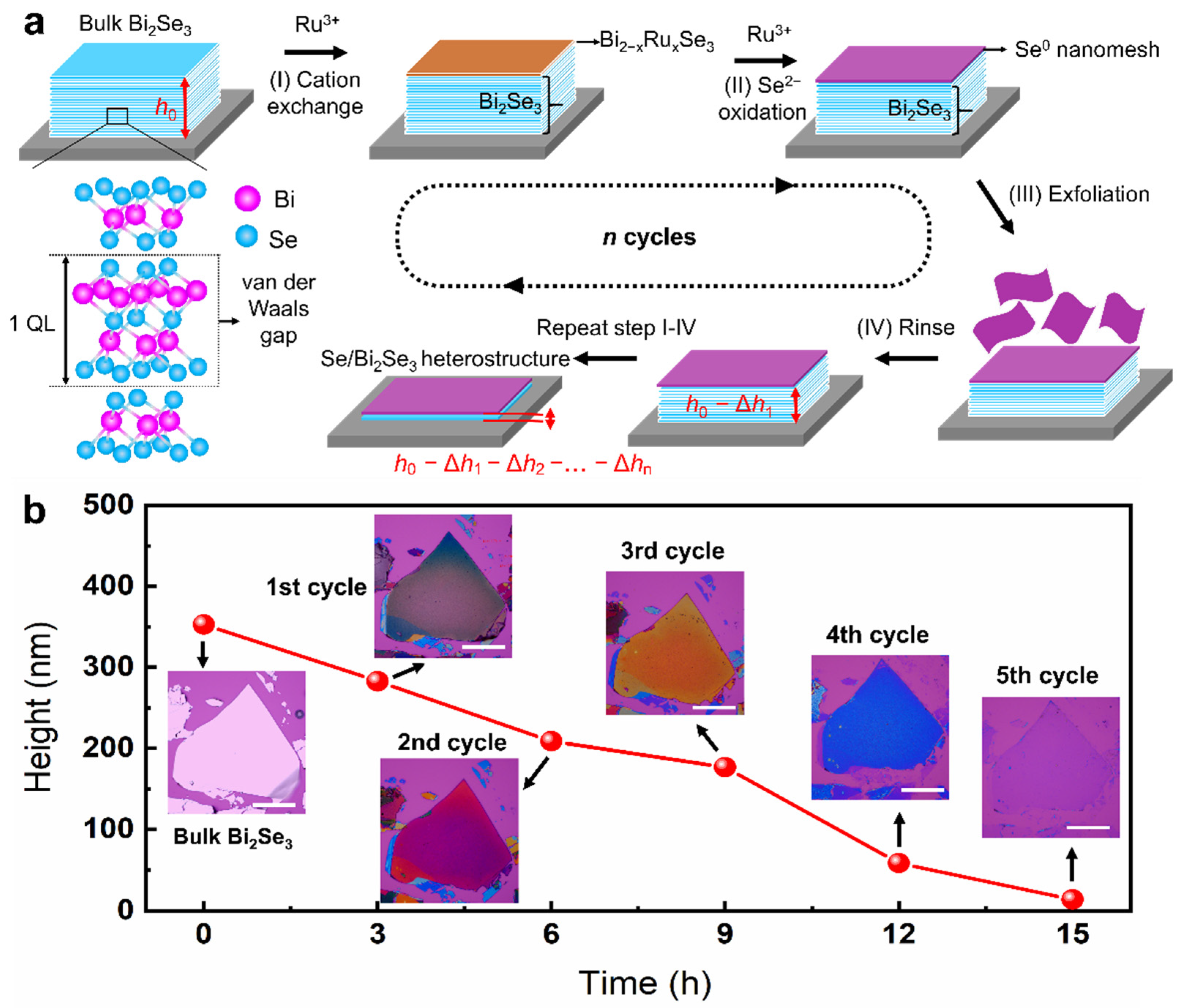
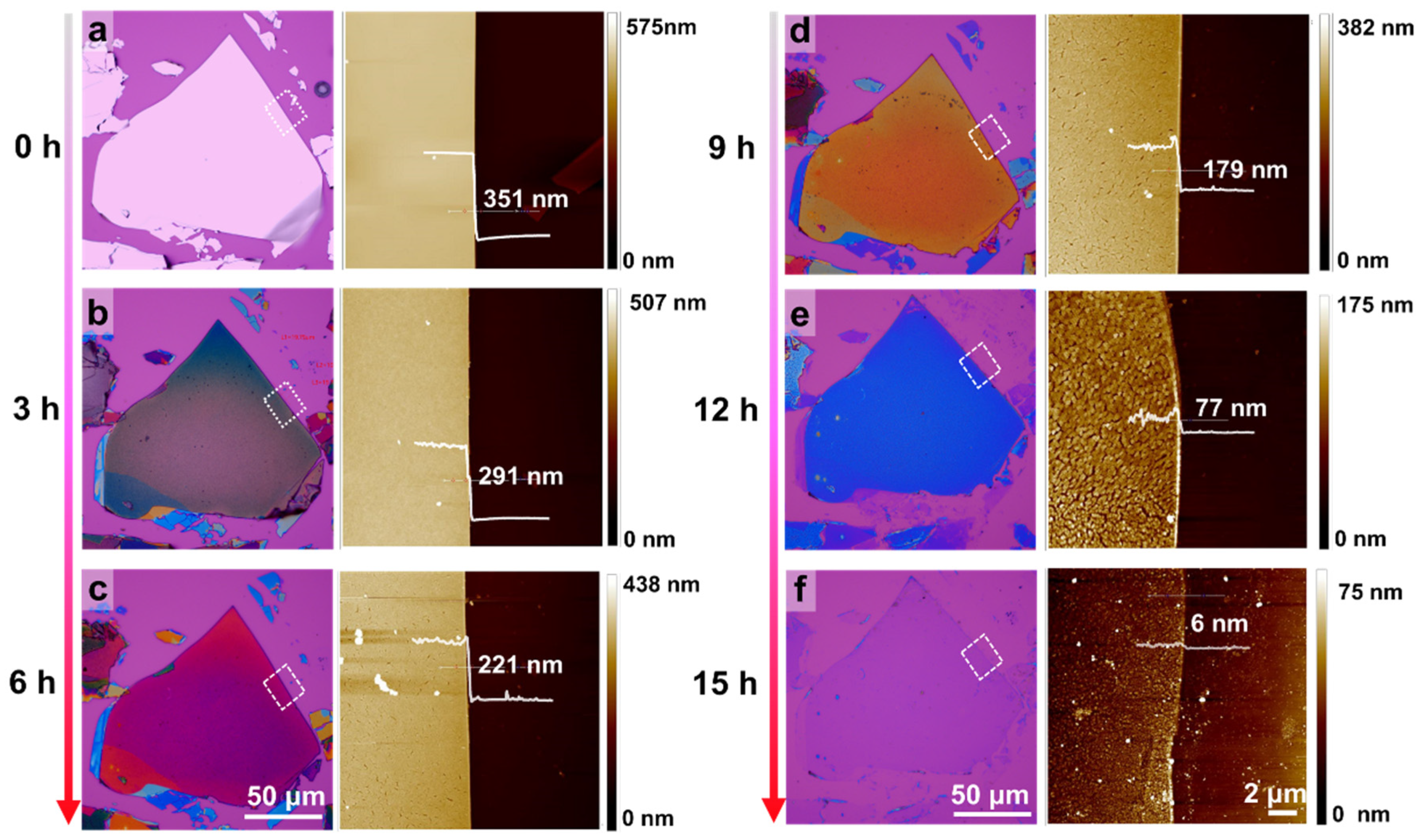
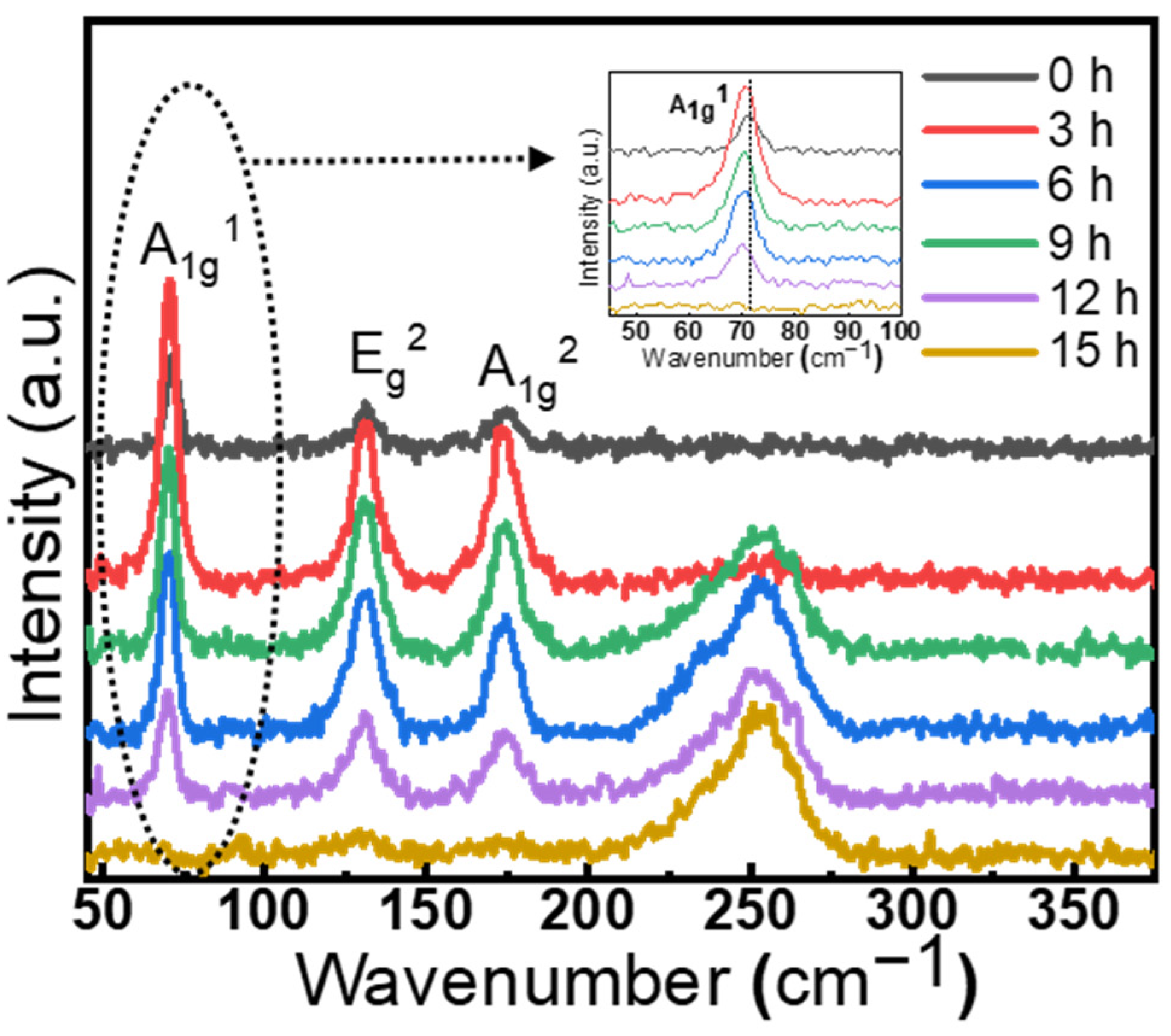
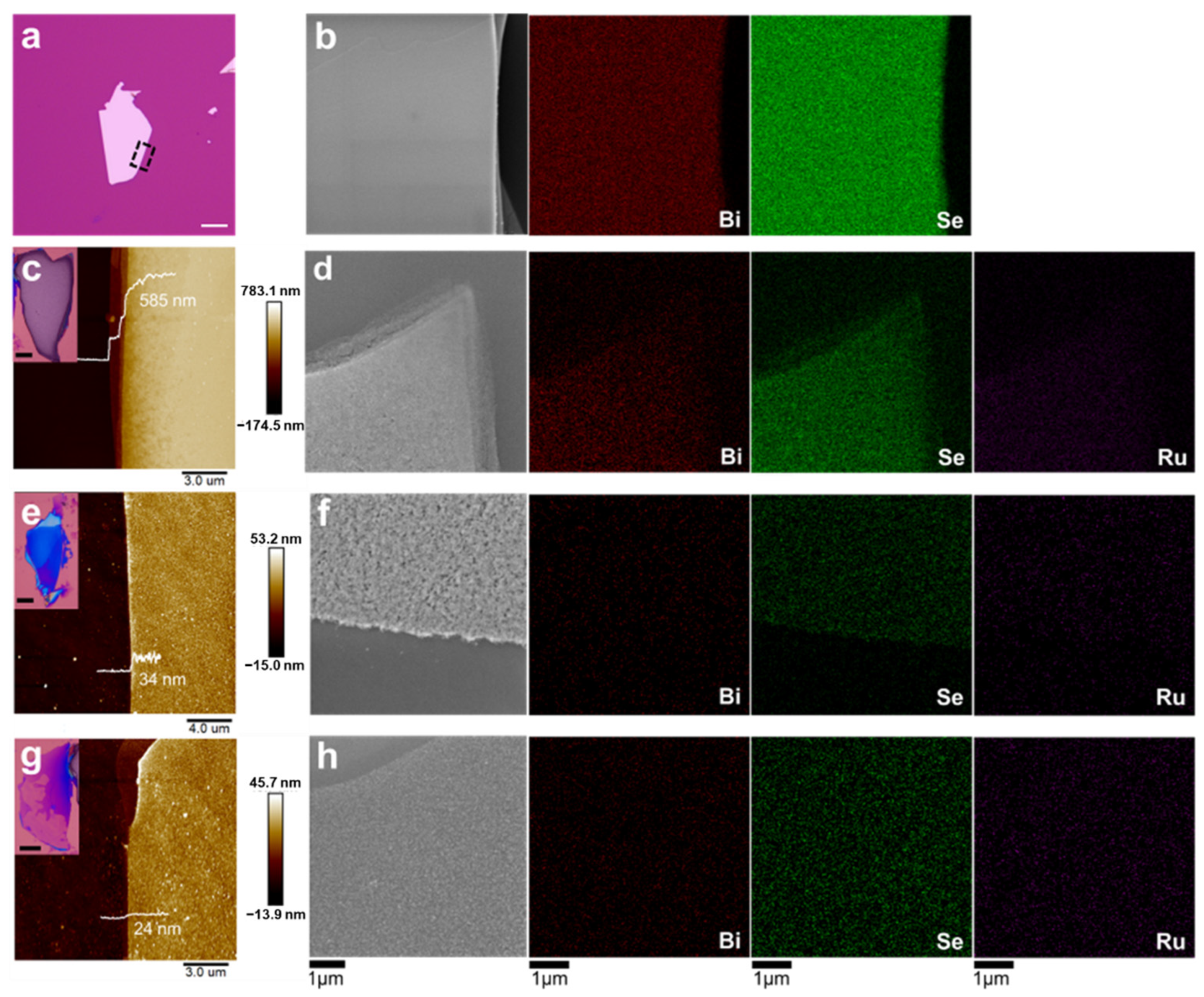
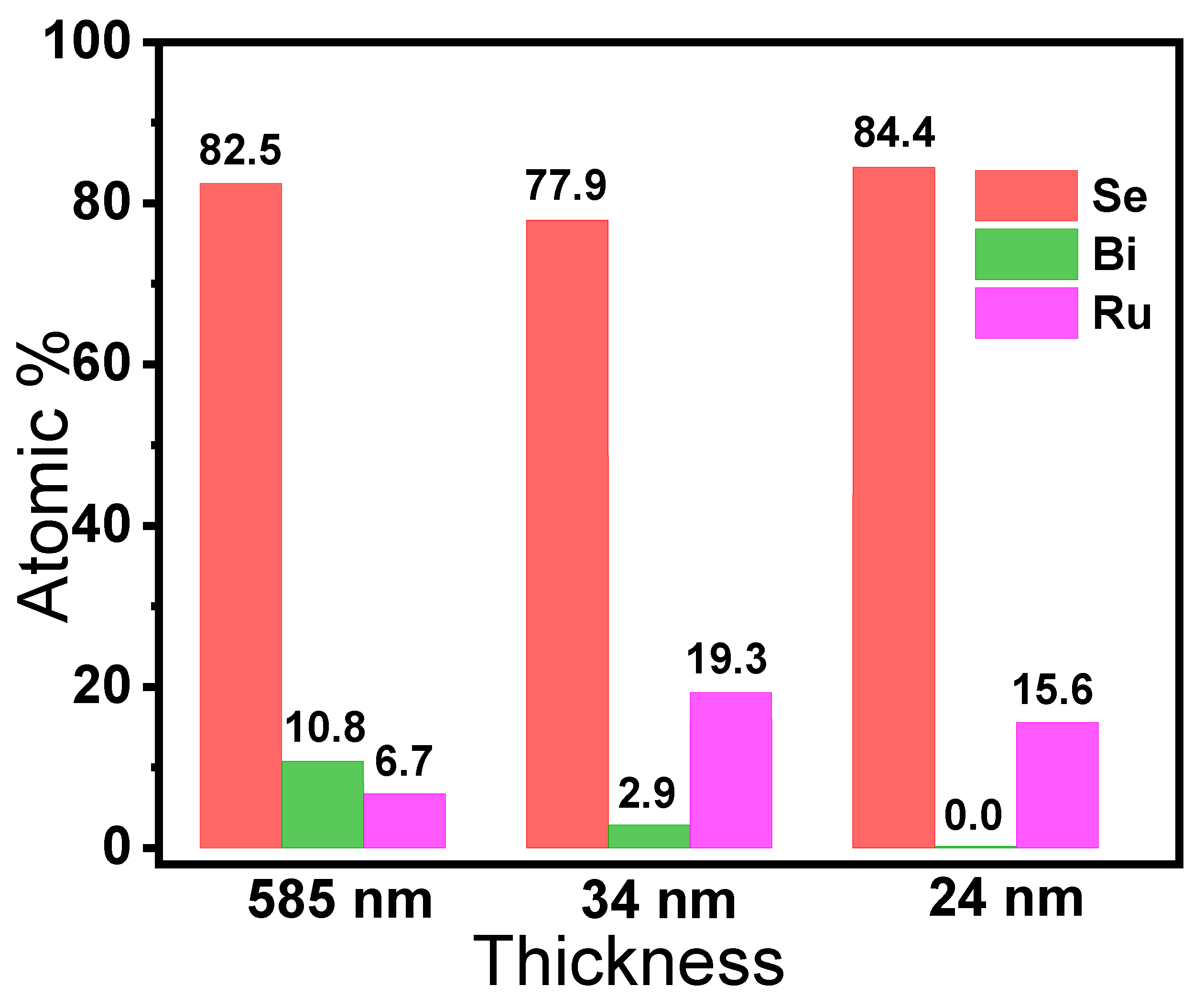
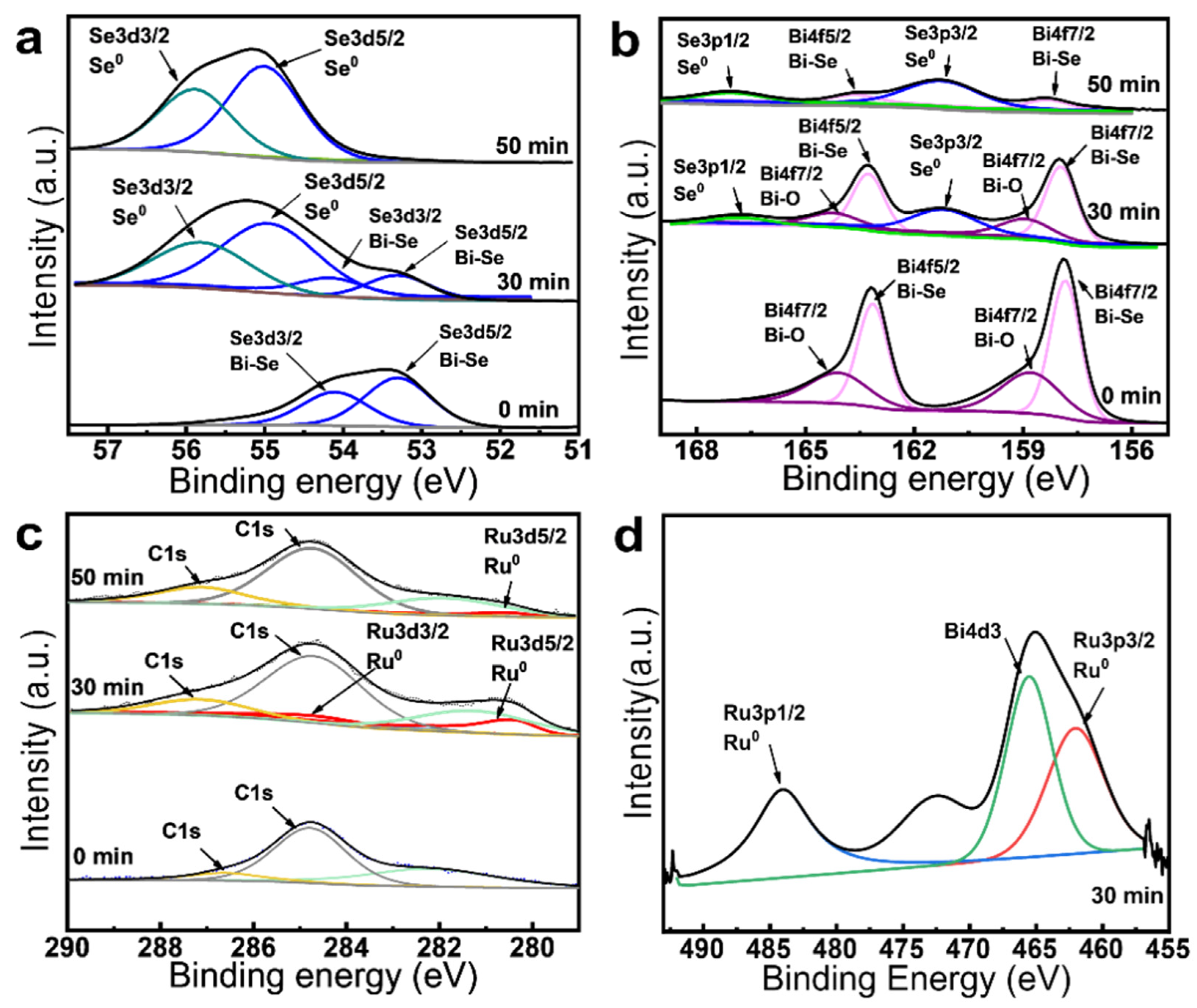
Publisher’s Note: MDPI stays neutral with regard to jurisdictional claims in published maps and institutional affiliations. |
© 2022 by the authors. Licensee MDPI, Basel, Switzerland. This article is an open access article distributed under the terms and conditions of the Creative Commons Attribution (CC BY) license (https://creativecommons.org/licenses/by/4.0/).
Share and Cite
Kang, Y.; Tan, Y.; Zhang, R.; Xie, X.; Hua, W. In-Situ Chemical Thinning and Surface Doping of Layered Bi2Se3. Nanomaterials 2022, 12, 3725. https://doi.org/10.3390/nano12213725
Kang Y, Tan Y, Zhang R, Xie X, Hua W. In-Situ Chemical Thinning and Surface Doping of Layered Bi2Se3. Nanomaterials. 2022; 12(21):3725. https://doi.org/10.3390/nano12213725
Chicago/Turabian StyleKang, Yan, Yinlong Tan, Renyan Zhang, Xiangnan Xie, and Weihong Hua. 2022. "In-Situ Chemical Thinning and Surface Doping of Layered Bi2Se3" Nanomaterials 12, no. 21: 3725. https://doi.org/10.3390/nano12213725
APA StyleKang, Y., Tan, Y., Zhang, R., Xie, X., & Hua, W. (2022). In-Situ Chemical Thinning and Surface Doping of Layered Bi2Se3. Nanomaterials, 12(21), 3725. https://doi.org/10.3390/nano12213725





